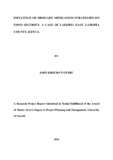| dc.description.abstract | Achieving food security in the Kenyan ASALs during drought is a constant challenge that begs for action. Reactive crisis approach to drought-risk management have over time been ineffective and poorly coordinated leading vulnerability of households to food insecurity despite development and implementation of drought risk mitigation strategies under HFA 2005-2015. This study sought to establish how drought mitigation strategies influence household food security in Laikipia East sub-County, Laikipia County, Kenya. The specific objectives looked at how drought preparedness, drought response activities and drought reconstruction activities after drought influence household food security. The study used descriptive research design. The population targeted was agro-pastoral households in Laikipia East Sub-county. Five sub-areas were purposively selected for the study. A sample was selected by use of Krejcie and Morgan table for determining sample size and sample of 242 households was selected from a target population of 649 households. Data was collected by use of questionnaires administered in the field to randomly selected households and eight key informants making a total of 250 respondents. However received filled questionnaires from the households, 219 were considered complete and reflective of study objectives. Data was analyzed by use of Statistical Package for Social Scientists and Microsoft Excel and presented using tables and subsequently interpreted. The findings of the study were that drought mitigation strategies influenced household food security but they were poorly coordinated, late, and insufficient and also lacked sufficient funding. The study also found out that household participation was low in implementation. The study recommends more capacity building on drought mitigation strategies, timely planning for drought to ensure coordinated response to drought especially in human and livestock relief projects. Finally the study recommends involvement of technical field officials and local leaders as they are better placed to identify working strategies and rightful targeting. | en_US |

